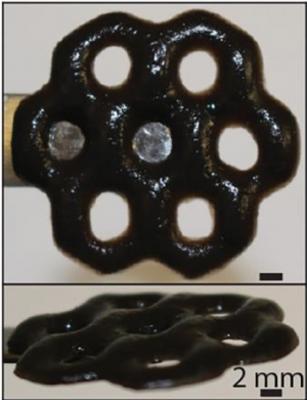Researchers at Brown University, the University of Wisconsin and the National University of Singapore have developed a way of reinforcing hydrogel materials made from alginate, a natural material derived from seaweeds that’s currently used in a variety of biomedical applications, by incorporating graphene oxide into its structure.

This produces a material that can be 3D printed into structures that are stiffer and more fracture resistant than alginate alone - an important achievement as alginate tends to be fragile and thus hard to work with. Furthermore, the material is also capable of becoming stiffer or softer in response to different chemical treatments, meaning it could be used to make smart materials that are able to react to their surroundings in real time. In addition, alginate-GO retains alginate’s ability to repel oils, giving the new material potential as an anti-fouling coating.
One advantage to the technique is that the sodium alginate polymers link through ionic bonds. The bonds are strong enough to hold the material together, but they can be broken by certain chemical treatments. That gives the material the ability to respond dynamically to external stimuli. Previously, the Brown researchers showed that this ionic crosslinking can be used to create alginate materials that degrade on demand, rapidly dissolving when treated with a chemical that sweeps away ions from the material’s internal structure.
For this new study, the researchers wanted to see how graphene oxide might influence the mechanical properties of alginate structures. They showed that alginate-GO could be made twice as stiff as alginate alone, and far more resistant to failure through cracking. The addition of graphene oxide stabilizes the alginate hydrogel with hydrogen bonding, said Ian Y. Wong, an assistant professor of engineering at Brown and the paper’s senior author. We think the fracture resistance is due to cracks having to detour around the interspersed graphene sheets rather than being able to break right though homogeneous alginate.
The extra stiffness enabled the researchers to print structures that had overhanging parts, which would have been impossible using alginate alone. Moreover, the increased stiffness didn’t prevent alginate-GO from responding to external stimuli like alginate alone can. The researchers showed that by bathing the materials in a chemical that removes its ions, the materials swelled up and became much softer. The materials regained their stiffness when ions were restored through bathing in ionic salts. Experiments showed that the materials’ stiffness could be tuned over a factor of 500 by varying their external ionic environment.
You could imagine a scenario where you can image living cells in a stiff environment and then immediately change to a softer environment to see how the same cells might respond, the team said. That could be useful in studying how cancer cells or immune cells migrate through different organs throughout the body.
Since alginate-GO retains the powerful oil-repellant properties of pure alginate, the new material could make an excellent coating to keep oil and other such substances from building up on surfaces. In a series of experiments, the researchers showed that a coating of alginate-GO could keep oil from fouling the surface of glass in highly saline conditions. That could make alginate-GO hydrogels useful for coatings and structures used in marine settings, the researchers say.
These composite materials could be used as a sensor in the ocean that can keep taking readings during an oil spill, or as an anti-fouling coating that helps to keep ship hulls clean, the researchers said. The extra stiffness afforded by the graphene would make such materials or coatings far more durable than alginate alone.
The researchers plan to continue experimenting with the new material, looking for ways to streamline its production and continue to optimize its properties.